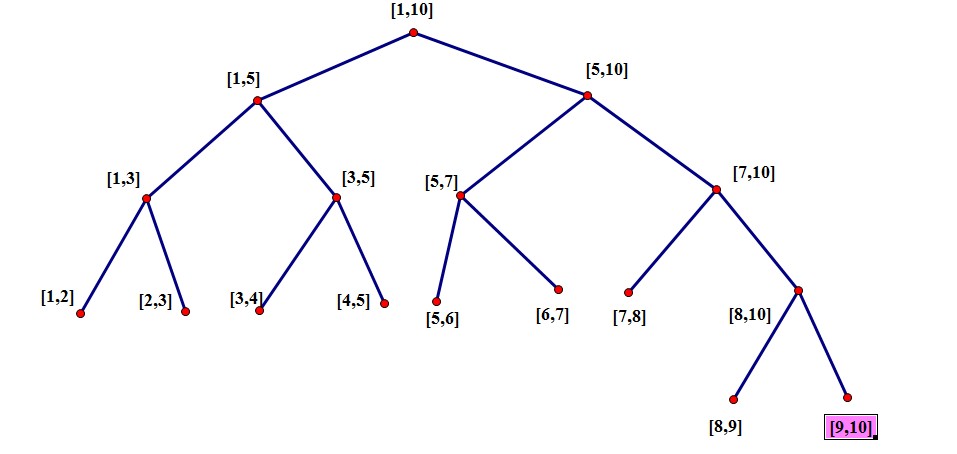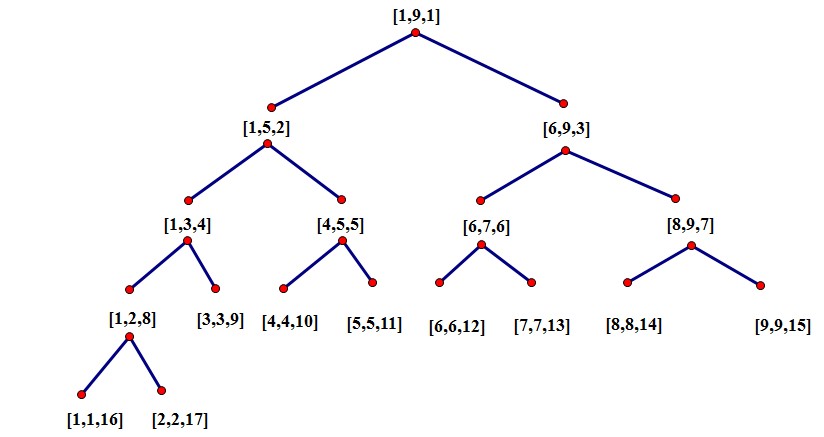HH神的线段树出神入化,所以跟着HH学习线段树。
风格:
maxn是题目给的最大区间,而节点数要开4倍,确切的说……
lson和rson辨别表示结点的左孩子和右孩子。
PushUp(int rt)是把当前结点的信息更新到父节点
PushDown(int rt)是把当前结点的信息更新给孩子结点。
rt表示当前子树的根(root),也就是当前所在的结点。
思想:
对于每个非叶节点所标示的结点 [a,b],其做孩子表示的区间是[a,(a+b)/2],其右孩子表示[(a+b)/2,b].
构造:

离散化和线段树:
题目:x轴上有若干个线段,求线段覆盖的总长度。
普通解法:设置坐标范围[min,max],初始化为0,然后每一段分别染色为1,最后统计1的个数,适用于线段数目少,区间范围小。
离散化的解法:离散化就是一一映射的关系,即将一个大坐标和小坐标进行一一映射,适用于线段数目少,区间范围大。
例如:[10000,22000],[30300,55000],[44000,60000],[55000,60000].
第一步:排序 10000 22000 30300 44000 55000 60000
第二部:编号 1 2 3 4 5 6
第三部:用编号来代替原数,即小数代大数 。
[10000,22000]~[1,2]
[30300,55000]~[3,5]
[44000,60000]~[4,6]
[55000,60000]~[5,6]
然后再用小数进行普通解法的步骤,最后代换回去。
线段树的解法:线段树通过建立线段,将原来染色O(n)的复杂度减小到 log(n),适用于线段数目多,区间范围小的情况。
离散化的线段树:适用于线段数目多,区间范围大的情况。
构造:
动态数据结构:
struct node{
node* left;
node* right;
……
}
静态全局数组模拟(完全二叉树):
struct node{
int left;
int right;
……
}Tree[MAXN]
例如:

线段树与点树:
线段树的每一个结点表示一个点,成为点树,比如说用于求第k小数的线段树。
点树结构体:
struct node{
int l, r;
int c;//用于存放次结点的值,默认为0
}T[3*MAXN];
创建:
创建顺序为先序遍历,即先构造根节点,再构造左孩子,再构造右孩子。
void construct(int l, int r, int k){
T[k].l = l;
T[k].r = r;
T[k].c = 0;
if(l == r) return ;
int m = (l + r) >> 1;
construct(l, m, k << 1);
construct(m + 1, r, (k << 1) + 1);
return ;
}

[A,B,C]:A表示左值,B表示右值,C表示在静态数组中的位置,由此可知,n个点的话大约共有2*n个结点,因此开3*n的结构体一定是够的。
更新值:
void insert(int d, int k){
//如果找到了就c值+1返回。
if(T[k].l == T[k].r && d == T[k].l){
T[k].c += 1;
return ;
}
int m = (T[k].l + T[k].r) >> 1;
if(d <= m) insert(d, k << 1);
else insert(d, (k << 1) + 1);
//更新每一个c,向上更新
T[k].c = T[k << 1].c + T[(k << 1) + 1].c;
}
查找值:
//k表示树根,d表示要查找的值
void search(int d, int k, int& ans)
{
if(T[k].l == T[k].r){
ans = T[k].l;
ans = T[k].l;
}
int m = (T[k].l + T[k].r) >> 1;
//不懂
if(d > T[(k << 1)].c) search(d - T[k << 1].c, (k << 1) + 1, ans);
else search(d, k << 1, ans);
}
search函数的用法不太懂。
例题解:
(待更新)
四类题型:
1.单点更新 只更新叶子结点,然后把信息用PushUp(int r)这个函数更新上来。
hdu1166:敌兵布阵
线段树功能:update:单点替换 query:区间最值
poj2828
树状数组:
#include <iostream>
#include <cstdio>
#include <string>
#include <cstring>
using namespace std;
typedef pair<int, int> PII;
const int maxn = 200000;
int C[maxn + 100];
int B[maxn + 100];
int n;
PII arr[maxn + 100];
int lowbit(int k) { return k & (-k); }
void init() {
for(int i = 1; i <= n; i++) C[i] = lowbit(i);
memset(B, -1, n + 10);
}
void update(int i) {
while(i <= n) {
C[i]--;
i += lowbit(i);
}
}
int query(int i) {
int ret = 0;
while(i > 0) {
ret += C[i];
i -= lowbit(i);
}
return ret;
}
void debug() {
for(int i = 1; i <= n; i++) cout << i << " " << query(i) << endl;
}
void fun(int a, int v) {
int l = 1, r = n;
while(l < r) {
int m = (l + r) >> 1;
if(query(m) >= a) r = m;
else l = m + 1;
}
//cout << "here " << l << endl;
update(l);
//cout << "here2 " << endl;
//debug();
B[l] = v;
//return l;
}
int main() {
while(~scanf("%d", &n)) {
init();
int a, b;
for(int i = 1; i <= n; i++) {
scanf("%d%d", &a, &b);
a++;
arr[i].first = a;
arr[i].second = b;
}
for(int i = n; i > 0; i--) fun(arr[i].first, arr[i].second);
//debug2();
//bool flag = false;
for(int i = 1; i <= n; i++) {
i == 1 ? printf("%d", B[i]) : printf(" %d", B[i]);
//if(B[i] != -1 && !flag) { printf("%d", B[i]); flag = true; }
//else if(B[i] != -1) printf(" %d", B[i]);
}
puts("");
}
return 0;
}
poj-3468
#include <cstdio>
#include <cstring>
#include <iostream>
using namespace std;
#define lson l, m, rt<<1
#define rson m+1, r, rt<<1|1
typedef long long LL;
const int maxn = 111111;
LL col[maxn<<2];
LL sum[maxn<<2];
void PushUp(LL rt) {
sum[rt] = sum[rt<<1] + sum[rt<<1|1];
}
//pushdown的作用是如果此点可以更新。
//也就是更新到下一层
//如果是底层,那么是不用pushdown的。
void PushDown(LL rt, LL m) {
if(col[rt]) {
//col[rt<<1] = col[rt<<1|1] = col[rt];
col[rt<<1] += col[rt];
col[rt<<1|1] += col[rt];
sum[rt<<1] += col[rt] * (m - (m>>1));
sum[rt<<1|1] += col[rt] * (m>>1);
col[rt] = 0;
}
}
void build(LL l, LL r, LL rt) {
col[rt] = 0;
//cout << l << " " << r << endl;
if(l == r) {
scanf("%I64d", &sum[rt]);
//cout << rt << " " << sum[rt] << endl;
return ;
}
int m = (l + r) >> 1;
build(lson);
build(rson);
PushUp(rt);
}
LL query(LL L, LL R, LL l, LL r, LL rt) {
LL ret = 0;
if(L <= l && r <= R) {
//if(col[rt]) return sum[rt] + (r - l + 1) * col[rt];
return sum[rt];
}
PushDown(rt, r - l + 1);
int m = (l + r) >> 1;
if(L <= m) ret += query(L, R, lson);
if(R > m) ret += query(L, R, rson);
return ret;
}
void update(LL L, LL R, LL c, LL l, LL r, LL rt) {
if(L <= l && r <= R) {
sum[rt] += c * (r - l + 1);
col[rt] += c;//子节点没有更新
return ;
}
PushDown(rt, r - l + 1);
int m = (l + r) >> 1;
if(L <= m) update(L, R, c, lson);
if(R > m) update(L, R, c, rson);
PushUp(rt);
}
void debug(int n) {
for(int i = 1; i <= (n*3); i++) {
cout << i << " ";
}
cout << endl;
for(int i = 1; i <= (n*3); i++) {
cout << col[i] << " ";
}
cout << endl << endl;
for(int i = 1; i <= (n*3); i++) {
cout << i << " ";
}
cout << endl;
for(int i = 1; i <= (n*3); i++) {
cout << sum[i] << " ";
}
cout << endl;
}
int main() {
LL N, Q;
while(~scanf("%I64d%I64d", &N, &Q)) {
//cout << "N = " << N << endl;
memset(sum, 0, sizeof(sum));
memset(col, 0, sizeof(col));
build(1, N, 1);
//debug(N);
for(int i = 0; i < Q; i++) {
char ch[3];
LL a, b, c;
scanf("%s", ch);
if(ch[0] == 'Q') {
scanf("%I64d%I64d", &a, &b);
printf("%I64d
", query(a, b, 1, N, 1));
}
else {
scanf("%I64d%I64d%I64d", &a, &b, &c);
update(a, b, c, 1, N, 1);
}
//debug(N);
}
}
return 0;
}